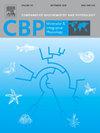Physiological response and lipid metabolism induced by re-feeding in Jian carp (Cyprinus carpio var. Jian) subjected to short-term starvation
IF 2.2
3区 生物学
Q4 BIOCHEMISTRY & MOLECULAR BIOLOGY
Comparative Biochemistry and Physiology A-Molecular & Integrative Physiology
Pub Date : 2025-03-03
DOI:10.1016/j.cbpa.2025.111832
引用次数: 0
Abstract
The effects of starvation and re-feeding on Jian carp (Cyprinus carpio var. Jian) remain incompletely understood. This study investigated changes in growth performance, liver antioxidant capacity, intestinal morphology, fatty acid profile, and expression of genes related to lipid metabolism. Juvenile C. carpio var. Jian, with initial body weight of 29.50 ± 2.00 g, were reared in 15 cylindrical culture barrels (200L) at a stocking density of 10 fish per barrel. These fish were subjected to five feeding regimes: a continuous feeding group (control group, treatment A), complete fasting (treatment B), 1, 2, and 3 days starvation within one week, followed by re-feeding 6 days (treatment C), 5 days (treatment D), and 4 days (treatment E). The results indicated significantly lower growth performance in C. carpio var. Jian in treatments B and E compared to the control and treatment C (P < 0.05). Intestinal length (only 627 ± 13.14 μm in treatment B) was significantly reduced, and an increase in vacuoles was observed in C. carpio var. Jian with the prolonged starvation. Antioxidant enzyme activities of superoxide dismutase (SOD), catalase (CAT), and glutathione peroxidase (GPx) were significantly (P < 0.05) improved in treatment C when compared with treatments B, D and E.. In contrast, malondialdehyde (MDA) value was lowest (12.62 ± 0.60 nmol/mL) in treatment B. Furthermore, continuous starvation significantly decreased the total lipid and fatty acids contents in the muscle (P < 0.05). Compared with the control group, the reduction of total lipid and fatty acids contents was 31.53 % and 4.57 %, respectively, particularly affecting n3PUFA and n6PUFA. However, after one-day re-feeding, these contents resumed. Lipid metabolism is closely related to fish health, while in the current study, the genes related to lipid metabolism including lipoprotein lipase (LPL), 6-phosphogluconate dehydrogenase (G6PD), and peroxisome proliferator-activated receptor alpha (PPARα) did not differ significantly in treatment C compared to the control group (P > 0.05). In contrast, expressions in treatments B, D, and E were significantly reduced (P < 0.05). Taken together, prolonged starvation (>one day per week) not only affected the growth, which may further disrupt the intestinal structure, weaken antioxidant capacity, but also attenuate lipid deposition.

短期饥饿条件下建鲤复饲的生理反应及脂质代谢
饥饿和复饲对剑鲤的影响尚不完全清楚。本研究研究了生长性能、肝脏抗氧化能力、肠道形态、脂肪酸谱和脂质代谢相关基因表达的变化。试验选用15个圆柱形养殖桶(200L),饲养密度为10尾/桶,初始体重为29.50±2.00 g。研究人员对这些鱼进行了5种饲喂方案:连续饲喂组(对照组,处理a)、完全禁食组(处理B)、1周内饥饿1、2和3天,然后再饲喂6天(处理C)、5天(处理D)和4天(处理E)。结果表明,处理B和E的鲤鱼生长性能显著低于对照组和处理C (P <;0.05)。随着饥饿时间的延长,鲫鱼肠道长度(处理B仅为627±13.14 μm)显著缩短,空泡数量增加。超氧化物歧化酶(SOD)、过氧化氢酶(CAT)和谷胱甘肽过氧化物酶(GPx)的抗氧化酶活性显著(P <;C组与B、D、E组比较,差异有统计学意义(0.05)。b处理丙二醛(MDA)含量最低(12.62±0.60 nmol/mL),持续饥饿显著降低了肌肉中总脂质和脂肪酸含量(P <;0.05)。与对照组相比,总脂质和脂肪酸含量分别降低了31.53%和4.57%,其中n3PUFA和n6PUFA的影响最大。然而,经过一天的重新喂食,这些内容恢复了。脂质代谢与鱼类健康密切相关,而在本研究中,与脂质代谢相关的基因包括脂蛋白脂肪酶(LPL)、6-磷酸葡萄糖酸脱氢酶(G6PD)和过氧化物酶体增殖物激活受体α (PPARα)在处理C中与对照组相比没有显著差异(P >;0.05)。相比之下,处理B、D和E的表达显著降低(P <;0.05)。综上所述,长期饥饿(每周1天)不仅影响了生长,可能进一步破坏肠道结构,削弱抗氧化能力,还会减弱脂质沉积。
本文章由计算机程序翻译,如有差异,请以英文原文为准。
求助全文
约1分钟内获得全文
求助全文
来源期刊
CiteScore
5.00
自引率
4.30%
发文量
155
审稿时长
3 months
期刊介绍:
Part A: Molecular & Integrative Physiology of Comparative Biochemistry and Physiology. This journal covers molecular, cellular, integrative, and ecological physiology. Topics include bioenergetics, circulation, development, excretion, ion regulation, endocrinology, neurobiology, nutrition, respiration, and thermal biology. Study on regulatory mechanisms at any level of organization such as signal transduction and cellular interaction and control of behavior are also published.

 求助内容:
求助内容: 应助结果提醒方式:
应助结果提醒方式:


